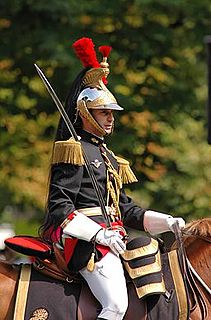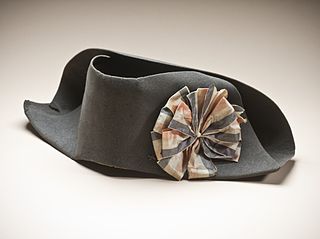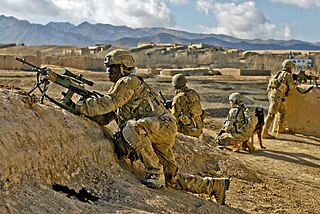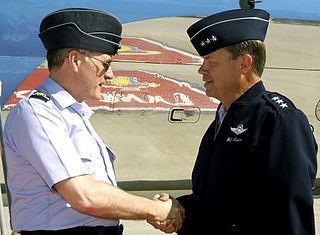Campaign Cords or Campaign Hat Cords are decorations generally worn around a variety of types of serviceman's hats to indicate station, unit, rank or history of service. They are generally used in the military or Police services, and mostly in the United States.
Military ranks are a system of hierarchical relationships in armed forces, police, intelligence agencies or other institutions organized along military lines. Military ranks and the military rank system define among others dominance, authority, as well as roles and responsibility in a military hierarchy. The military rank system incorporates the principles of exercising power and authority, and the military chain of command – the succession of commanders superior to subordinates through which command is exercised – constructs an important component for organized collective action.

The police are a constituted body of persons empowered by a state to enforce the law, to protect the lives, liberty and possessions of citizens, and to prevent crime and civil disorder. Their powers include the power of arrest and the legitimized use of force. The term is most commonly associated with the police forces of a sovereign state that are authorized to exercise the police power of that state within a defined legal or territorial area of responsibility. Police forces are often defined as being separate from the military and other organizations involved in the defense of the state against foreign aggressors; however, gendarmerie are military units charged with civil policing. Police forces are usually public sector services, funded through taxes.

The United States of America (USA), commonly known as the United States or America, is a country composed of 50 states, a federal district, five major self-governing territories, and various possessions. At 3.8 million square miles, the United States is the world's third or fourth largest country by total area and is slightly smaller than the entire continent of Europe's 3.9 million square miles. With a population of over 327 million people, the U.S. is the third most populous country. The capital is Washington, D.C., and the largest city by population is New York City. Forty-eight states and the capital's federal district are contiguous in North America between Canada and Mexico. The State of Alaska is in the northwest corner of North America, bordered by Canada to the east and across the Bering Strait from Russia to the west. The State of Hawaii is an archipelago in the mid-Pacific Ocean. The U.S. territories are scattered about the Pacific Ocean and the Caribbean Sea, stretching across nine official time zones. The extremely diverse geography, climate, and wildlife of the United States make it one of the world's 17 megadiverse countries.
Hat cords were initially used on campaign hats by the military. They were initially used by the US military in the 19th century. Some were of a single colour, others were of a blend of colours, and the patterns of the multi coloured cords could vary. While mainly ornamental and not serving any practical purpose, they could indicate information about the wearer [1]

A campaign hat is a broad-brimmed felt or straw hat, with a high crown, pinched symmetrically at the four corners.
Campaign cords are generally made up of three components; the cord itself, the keeper and the acorns. The cord may wrap around the hat twice, while the keeper keeps the cord together, and allows for it to be adjusted for a different size hat. [2] The acorns are at the end of the cord and are mainly decoration, though obviously serve to stop the cord coming slipping out of the keeper.
Historically, they have been worn by the US military from the mid 19th century in the Indian campaigns, World War I, World War II to a lesser degree in the pacific theatre, and by Air Cavalry in Vietnam. They are also worn by a number of US police highway patrol and Sheriffs.

World War I, also known as the First World War or the Great War, was a global war originating in Europe that lasted from 28 July 1914 to 11 November 1918. Contemporaneously described as "the war to end all wars", it led to the mobilisation of more than 70 million military personnel, including 60 million Europeans, making it one of the largest wars in history. It is also one of the deadliest conflicts in history, with an estimated nine million combatants and seven million civilian deaths as a direct result of the war, while resulting genocides and the 1918 influenza pandemic caused another 50 to 100 million deaths worldwide.

World War II, also known as the Second World War, was a global war that lasted from 1939 to 1945. The vast majority of the world's countries—including all the great powers—eventually formed two opposing military alliances: the Allies and the Axis. A state of total war emerged, directly involving more than 100 million people from over 30 countries. The major participants threw their entire economic, industrial, and scientific capabilities behind the war effort, blurring the distinction between civilian and military resources. World War II was the deadliest conflict in human history, marked by 50 to 85 million fatalities, most of whom were civilians in the Soviet Union and China. It included massacres, the genocide of the Holocaust, strategic bombing, premeditated death from starvation and disease, and the only use of nuclear weapons in war.
A highway patrol is either a police unit created primarily for the purpose of overseeing and enforcing traffic safety compliance on roads and highways, or a detail within an existing local or regional police agency that is primarily concerned with such duties. They are also referred to in many countries as traffic police, although in other countries this term is more commonly used to refer to foot officers on point duty who control traffic at junctions.
Pre World War One campaign cords tended to be of more elaborate construction, with two or three strands making up the one cord, each of a different colour. Post World War One designs tend to be simpler in appearance and just have the one strand.
The colour of the cords could be indicative of the branch of the unit the wearer was with, and also denote rank. In 1941 campaign cords worn by US troops in the pacific had the enlisted men wearing a variety of colours depending on their functions, while officers mixed black and gold cords. [3] Some units found them of no use and discarded them from their uniform [4]
Campaign cords are worn on service hats worn by US Sheriffs and mainly historically worn on campaign hats by the US military, while the police wear them with either traditional Sheriff style, cattleman's or trooper, style hats, either made of straw or felt. They are worn by a number of highway patrol police officers including those of Arizona, Utah, South Carolina, Ohio, Kansas, Washington State and Maine.















